

Article (Advance) Exercise & Practice with Explanation. What Is a Prepositional Phrase and How to Use It? A prepositional phrase is a group of words consisting of a preposition, its object, and any words that modify the object.
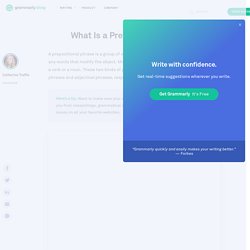
Most of the time, a prepositional phrase modifies a verb or a noun. These two kinds of prepositional phrases are called adverbial phrases and adjectival phrases, respectively. Here’s a tip: Want to make sure your writing always looks great? Grammarly can save you from misspellings, grammatical and punctuation mistakes, and other writing issues on all your favorite websites. At a minimum, a prepositional phrase consists of one preposition and the object it governs.
Is she really going out ? To these two basic elements, modifiers can be freely added. He arrived in the nick of time. Ejercicio de Have to - questions. Have to упражнения. Exercises have to. Продолжаем наш марафон упражнений на модальные глаголы, который мы начали с упражнений на can, may и must.
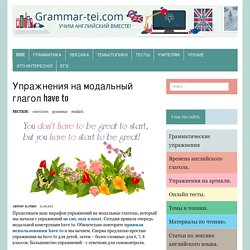
Сегодня пришла очередь модальной конструкции have to. Обязательно повторите правила использования have to и мы начнем. Сперва предлагаю простые упражнения на have to для детей, затем – более сложные для 6, 7, 8 классов. Большинство упражнений - с ответами для самоконтроля. Упражнение 1. Упражнение 2. An English-Zone.Com Lesson: Have to / Has to / Don't have to / Doesn't have to. Superlative adjectives exercise.
Plural of Nouns - English Grammar. Regular Plural Forms We form the plural of a noun with the singular + s parrot – parrots / apple – apples / girl – girls Nouns ending with y if a consonant is written before.
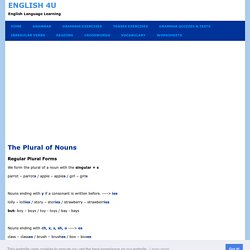
----> ies lolly – lollies / story – stories / strawberry – strawberries. Singular and plural exercises - The English Classroom. Adverbs - Adverbs of Certainty - Learn English Grammar. Adverbs of certainty let us describe how sure or certain we are about something.
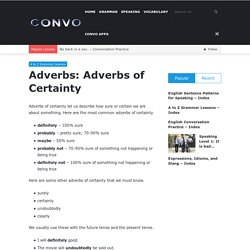
Here are the most common adverbs of certainty. definitely – 100% sure probably – pretty sure; 70-90% sure maybe – 50% sure probably not – 70-90% sure of something not happening or being true definitely not – 100% sure of something not happening or being true Here are some other adverbs of certainty that we must know. surely certainly undoubtedly clearly We usually use these with the future tense and the present tense.
I will definitely good. But it is also possible to use them with the past tense to guess or make assumptions about the past. She probably went home. Now, let’s see where we put these adverbs. Here is where we put these adverbs in the present tense and past tense. Subject + adverb + verb… Subject + be verb + adverb + (not)… She definitely works here. Although,however,but,so,because. Grex2 su8. Comparative and superlative practice. Stative-verbs-list.pdf. Cohesion. Cohesion is one of the two qualities that give a written or spoken text unity and purpose, the other being coherence.

It refers to the use of linguistic devices to join sentences together, including conjunctions, reference words, substitution and lexical devices such as repetition of words, collocations and lexical groups. ExampleThe second sentence above has cohesive devices such as conjunctions (and, such as, including), articles (the), references (it), and collocations (join _____ together, lexical groups). In the classroomCohesion is an extensive area and can be approached at a discrete item level, e.g. practising article use or differing synonyms.
Types of Sentences in English (Simple, Compound, Complex) A word or a group of words expressing a complete and meaningful sense is called a sentence.
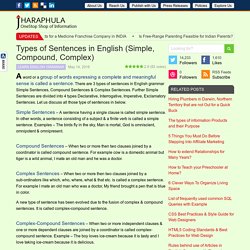
There are 3 types of sentences in English grammar Simple Sentences, Compound Sentences & Complex Sentences. Further Simple Sentences are divided into 4 types Declarative, Interrogative, Imperative, Exclamatory Sentences. Let us discuss all those type of sentences in below. Can and could (ability) practice. Talking about Past Abilities: could, was/were able to, and managed to - Business English. Gr.allow. Grammar - Intermediate: Past Perfect, Make Let & Allow. Past Perfect Structure We make the past perfect using had + the past participle.
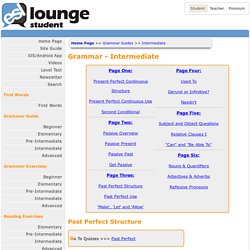
'Let' and 'Make' Make let allow. Narrative tenses : Past simple, Past perfect, Past continuous 1. T074 - Narrative Tenses. T074 - Narrative Tenses Gap-fill exercise Complete the sentences with the correct form of the verb (PAST and PAST PERFECT) !

We on the beach when it to rain (SIT, START). Simon returned the money he a week earlier (BORROW) While I was shopping my purse (STEAL) My letter did not arrive because I to put a stamp on it (FORGET) While he across Central Africa, John caught Malaria. Noun Phrases. Introduction Noun phrases (grouping together a collection of words to act as one noun) are one of the keystones of academic writing.
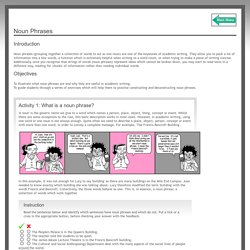
They allow you to pack a lot of information into a few words, a function which is extremely helpful when writing to a word count, or when trying to make a piece of writing concise. Additionally, once you recognise that strings of words (noun phrases) represent ideas which cannot be broken down, you may start to read texts in a different way, reading for 'chunks' of information rather than reading individual words. Objectives To illustrate what noun phrases are and why they are useful in academic writing. Activity 1: What is a noun phrase? Embedded Questions. Introduction An embedded question is a question that is included inside another question or statement.
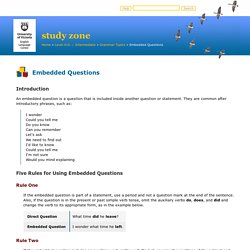
They are common after introductory phrases, such as: I wonder Could you tell me Do you know Can you remember Let's ask We need to find out I'd like to know Could you tell me I'm not sure Would you mind explaining Five Rules for Using Embedded Questions Rule One. Embedded Questions. An embedded question is a question that is inside another question or statement. This grammar point is sometimes explained on its own or in a lesson on noun clauses or reported speech (more on this below). Tip To help students remember what an embedded question is, think of “embed” as “in bed.” When you’re in bed, you’re tucked in between the sheets. Comparatives & Superlatives. Narrative tenses : Past simple, Past perfect, Past continuous 1. Narrative tenses exercise.
Verb patterns: verb + infinitive or verb + - ing ? — English Grammar Today — Cambridge Dictionary. Some verbs can be followed immediately by a to-infinitive: I can’t afford to go on holiday. It began to rain. She hopes to go to university next year. My mother never learnt to swim. Did you remember to ring Nigel? Some verbs are normally followed by the -ing form, not the to-infinitive: I always enjoy cooking. Not: I always enjoy to cook. We haven’t finished eating yet. Not: We haven’t finished to eat. She keeps changing her mind about the wedding. Some of these verbs (e.g. can’t stand, dislike, imagine, involve, mind, miss, put off and risk) can be used with a new subject before the -ing form (underlined in the examples below).